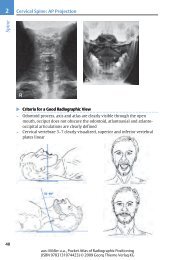Attachment 2
Attachment 2
Attachment 2
Create successful ePaper yourself
Turn your PDF publications into a flip-book with our unique Google optimized e-Paper software.
latinosa (Rexed II).<br />
2nd order neuron axon cross obliquely in the anterior white commissure ascending<br />
≈ 1-3 segments while crossing to enter the lateral spinothalamic tract.<br />
Synapse: VPL thalamus. 3rd order neurons pass through IC to postcentral gyrus<br />
(Brodmann’s areas 3, 1, 2).<br />
FINE TOUCH, DEEP PRESSURE & PROPRIOCEPTION: BODY<br />
Fine touch AKA discriminative touch. Receptors: Meissner’s & pacinian corpuscles,<br />
Merkel’s disks, free nerve endings.<br />
1st order neuron: heavily myelinated afferents; soma in dorsal root ganglion (no<br />
synapse). Short branches synapse in nucleus proprius (Rexed III & IV) of posterior gray;<br />
long fibers enter the ipsilateral posterior columns without synapsing (below T6: fasciculus<br />
gracilis; above T6: fasciculus cuneatus).<br />
Synapse: nucleus gracilis/cuneatus (respectively), just above pyramidal decussation.<br />
2nd order neuron axons form internal arcuate fibers, decussate in lower medulla as<br />
medial lemniscus.<br />
Synapse: VPL thalamus. 3rd order neurons pass through IC primarily to postcentral<br />
gyrus.<br />
ANT E R IOR<br />
P OST E R IOR<br />
trigeminal<br />
nerve {<br />
©2001 Mark S Greenberg, M.D.<br />
All rights reserved.<br />
Unauthorized use is prohibited.<br />
V1<br />
V2<br />
V3<br />
superior clavicular occipitals<br />
C2<br />
C2<br />
C3<br />
C5<br />
T2<br />
C3<br />
C4<br />
T3<br />
T4<br />
T6<br />
INTERCOSTALS<br />
posterior<br />
lateral<br />
medial<br />
axillary<br />
RADIAL<br />
post. cutaneous<br />
dorsal cutan.<br />
C4<br />
T2<br />
T4<br />
T6<br />
T8<br />
T10<br />
C5<br />
T2<br />
T12 T1<br />
musculocutan.<br />
C6<br />
L1<br />
medial cutan.<br />
radial<br />
S5<br />
clunials<br />
S3<br />
C8<br />
C7<br />
L2<br />
L3<br />
L4<br />
ilioinguinal<br />
lateral cutan.<br />
nerve of thigh<br />
median<br />
ulnar<br />
FEMORAL<br />
anterior<br />
cutaneous<br />
saphenous<br />
posterior<br />
cutaneous<br />
L3<br />
S1<br />
L4<br />
C8<br />
C7<br />
L5<br />
SCIATIC<br />
COMMON PERONEAL<br />
lat. cutan.<br />
sup. peroneal<br />
deep peroneal<br />
TIBIAL<br />
L4<br />
L5<br />
sural<br />
med.<br />
plantars<br />
{lat.<br />
S1<br />
C6<br />
T1<br />
T8<br />
T10<br />
T12<br />
S1<br />
S4<br />
DERMATO MES<br />
CUT ANEOUS<br />
DERMATO M ES<br />
(anterior) NER VES<br />
(posterior)<br />
Figure 5-13 Dermatomal and sensory nerve distribution<br />
(Redrawn from “Introduction to Basic Neurology”, by Harry D. Patton, John W. Sundsten, Wayne E. Crill and<br />
Phillip D. Swanson, © 1976, pp 173, W. B. Saunders Co., Philadelphia, PA, with permission)<br />
LIGHT (CRUDE) TOUCH: BODY<br />
Receptors: as fine touch (see above), also peritrichial arborizations.<br />
94 5. Neuroanatomy and physiology NEUROSURGERY






